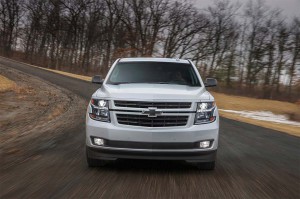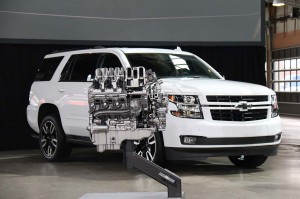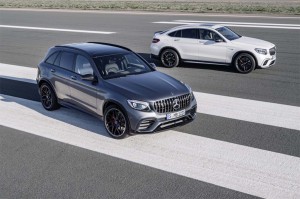General Motors is upping the performance quotient with the debut of the 2018 Chevrolet Tahoe RST. Short for Rally Sport Truck, it will target buyers who want the sort of power from a full-size SUV that they might normally expect from a muscle sedan or coupe.
Some manufacturers are content with cosmetic updates, and the RST does, indeed, add some sporty visual flourishes, like its gloss-black grille and mirror caps. But it’s what’s under the hood that’s likely to matter most to Tahoe buyers. The new version of the big ute offers an optional Performance Package that features a 420-horsepower 6.2-liter V-8 capable of launching from 0 to 60 in just 5.7 seconds.
“Customers are shifting over to crossovers and SUVs” in record numbers, said Sandor Pizar, the Chevy Truck marketing manager, during the Tahoe RST’s debut, “and a portion of them want performance.”
Chevrolet is by no means the only Detroit automaker betting there’s a market for muscle trucks.
(Is this SUV concept Toyota’s answer to Ford Bronco? Click Here for the story.)
At next week’s New York International Auto Show, Fiat Chrysler Automobiles will be putting the spotlight on performance. It plans to debut the new Dodge Challenger SRT Demon, a muscle coupe expected to come in somewhere between 800 and 900 horsepower. But it will also unveil the Jeep Grand Cherokee Trackhawk which, at 707 hp will be the most powerful factory-built SUV ever.

The Tahoe RST starts out with a number of sporty appearance tweaks and adds a range of optional performance upgrades.
Ironically, the Detroit makers who long dominated the classic SUV market are playing a bit of a catch-up game. Long known for sleek sports cars like the classic 911, Porsche was the first to put the sport in sport-utility vehicle with the launch of its original Cayenne model for the 2003 model-year. The Cayenne and newer Macan models now dominate the German carmaker’s sales and earnings.
Just this week, Daimler upped the ante with the debut of the Mercedes-AMG GLC 63. Three versions will be offered, with power from its biturbo 4.0-liter V-8 running from 469 to 503 hp. The top-line GLC 63 S Coupe will hit 60 in a mere 3.7 seconds, a figure that, not long ago, would have matched the likes of that Porsche 911.
(Volkswagen planning two versions of Tiguan, not one. Click Here to learn why.)
Off-the-line performance isn’t all that matters to SUV buyers, cautions Chevy’s Pizar, noting truck buyers “want to haul people, haul cargo and haul ass.” The Tahoe RST adds the ability to tow a trailer of up to 8,400 pounds, for one thing.
Meanwhile, unlike the classic muscle cars of years past, the bow-tie brand has taken steps to enhance both ride and handling. The RST can also be upgraded with GM’s magnetic ride control damping system. Also known as MagneRide, it uses shocks filled with a magnetic fluid that can shift from hard to soft – or anywhere in-between – as often as 200 times a second. The same technology is found on the Chevrolet Corvette, the Cadillac CTS-V and some new Ferrari models.
For the moment, Chevrolet planners aren’t making any sales forecasts, instead saying they will watch the market and flex production to meet demand.
“It’s going to be interesting to watch” and see how Detroit muscle utes like the Chevy Tahoe RST and Jeep Trackhawk fare, said Stephanie Brinley, a senior analyst with IHS Automotive. But she said that considering the large shift from passengers cars to light trucks – which now account for almost two-thirds of the U.S. new vehicle market – “this is fairly predictable.”
That’s all the more so with gas at just over $2 a gallon in most of the country, Brinley added. “But I still have a lot of questions about what sort of legs the performance truck segment will have over the next five to 10 years.”
That could depend on a variety of factors, including not only the price of gas but what the Trump Administration plans to do about the Corporate Average Fuel Economy standard. In the weeks before Barack Obama left office, the EPA declared it was going ahead with the 54.5 mpg Corporate Average Fuel Economy, or CAFE, standard set to phase in through 2025.
Last month, however, Pres. Donald Trump signed an Executive Order requiring the EPA to reopen a so-called mid-term review which, many observers believe, could result in a rollback of the mileage rules.
For his part, Eric Stanczak, the chief engineer on the Tahoe RST, said Chevy has taken steps to boost fuel economy, as well as performance. That includes the use of a high-efficiency 10-speed automatic transmission for the first time in a GM truck. The 6.2-liter V-8 also can shut off half of its cylinder when power demands are low, further reducing fuel consumption.
That said, if CAFE were to hold at 54.5 mpg, analyst Brinley cautioned, it would make it difficult for automakers like GM to continue marketing muscle trucks, at least in any sort of volume. If the standards are rolled back, the SUV performance market could be in for some significant growth.
(Lincoln planning to build all-new SUV in China. Click Here for the story.)



I Feel the Jeep Grand Cherokee SRT 8 was the first to put sport in sport utility. Fastest 0-60 time in wet and dry pavement. There may be others; however, I thought it came before the Cayenne. Please use this a compliment that someone reads what you print and likes your work. Thank you please keep up the Great work. Open for all ideas too.
Thanks, Michael, and I’m glad you raised the point. What seems clear is that we’re now seeing a real push to put SPORT into sport-utes.
Paul E.
I believe the Cayenne came first as it was available with a pretty healthy V8, then the Turbo S model came out. I think that had 450hp; I don’t think it got the diesel but it’s platform-mate VW got it, along with a W8. For some reason I want to say there was a V10 version but I may be mistaken.
The GC was still on the older platform; the first SRT8s were the 300C, Charger and Magnum, then I believe the GC and next the Challenger. I believe the Durango stayed RT as in the 5.9 RT Dakota / Durango. And there was an “R/T” on all the other underlings, an SRT4 Neon and Caliber.
Don’t forget the MBs, the G-Wagen had a twin-turbo setup. BMW had the 6-series with its convoluted styling and there was an X5M / X6M thrown in there at some point, after 2003 of course.